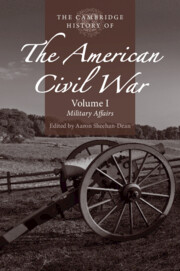Book contents
- The Cambridge History of the American Civil War
- The Cambridge History of the American Civil War
- The Cambridge History of the American Civil War
- Copyright page
- Contents
- Maps
- Contributors to Volume I
- Acknowledgments
- Note on the Text
- 1 Introduction: The Cambridge History of the American Civil War
- Part I Major Battles and Campaigns
- 2 The Battles of Virginia, 1861
- 3 The Battles of Tennessee, 1862
- 4 The Battles of the Trans-Mississippi, 1861–1863
- 5 The Peninsula Campaign
- 6 The Shenandoah Valley Campaigns of 1862 and 1864
- 7 The Second Bull Run Campaign
- 8 The Antietam Campaign
- 9 The Western Theater, 1862–1863
- 10 The Battle of Fredericksburg
- 11 The Chancellorsville Campaign
- 12 The Gettysburg Campaign
- 13 The Vicksburg Campaign
- 14 The Battles of Tennessee, 1863
- 15 The Overland Campaign
- 16 The Georgia Campaign
- 17 The Carolinas Campaign
- 18 The Tennessee Campaign, 1864
- 19 The Petersburg and Appomattox Campaigns
- Part II Places
- Index
- References
11 - The Chancellorsville Campaign
from Part I - Major Battles and Campaigns
Published online by Cambridge University Press: 11 October 2019
- The Cambridge History of the American Civil War
- The Cambridge History of the American Civil War
- The Cambridge History of the American Civil War
- Copyright page
- Contents
- Maps
- Contributors to Volume I
- Acknowledgments
- Note on the Text
- 1 Introduction: The Cambridge History of the American Civil War
- Part I Major Battles and Campaigns
- 2 The Battles of Virginia, 1861
- 3 The Battles of Tennessee, 1862
- 4 The Battles of the Trans-Mississippi, 1861–1863
- 5 The Peninsula Campaign
- 6 The Shenandoah Valley Campaigns of 1862 and 1864
- 7 The Second Bull Run Campaign
- 8 The Antietam Campaign
- 9 The Western Theater, 1862–1863
- 10 The Battle of Fredericksburg
- 11 The Chancellorsville Campaign
- 12 The Gettysburg Campaign
- 13 The Vicksburg Campaign
- 14 The Battles of Tennessee, 1863
- 15 The Overland Campaign
- 16 The Georgia Campaign
- 17 The Carolinas Campaign
- 18 The Tennessee Campaign, 1864
- 19 The Petersburg and Appomattox Campaigns
- Part II Places
- Index
- References
Summary
After the devastating Union defeat at Fredericksburg in December 1862, both the Army of the Potomac and the Army of Northern Virginia repaired to seasonal camps, licked their wounds, and remained wary of their enemy. Major General Ambrose Burnside, still in command, decided to locate the Federal corps around Falmouth, Virginia (just north of Fredericksburg), in a large cluster, guarded to the west by the cavalry. The Confederate camps, hugging the southern bank of the Rappahannock, stretched from Port Royal to the south up to Banks and US fords to the north, with Major General J. E. B. Stuart’s cavalry guarding the westernmost approaches to the Fredericksburg area and posting videttes above the river. As the troops of both armies settled into winter quarters, they were treated to unusually pleasant weather. Christmas Day, 1862, dawned mild and bright. At his headquarters at Moss Neck, on the Corbin Estate grounds, Lieutenant General Stonewall Jackson entertained General Robert E. Lee, Brigadier General William Nelson Pendleton, Stuart, and their staffs, in a rare display of conviviality that underlay his stern, Presbyterian scruples. The turkeys, homemade biscuits, and other culinary delicacies the Rebel high command enjoyed that day belied the gnawing problem of adequate supply for the rank and file, who, as the winter wore onward, would find themselves reduced to half-rations. Two railroads, both only partially reliable and prone to breakdowns, supplied the Confederate army, ensuring that Lee would be vexed by logistical problems in the months leading up to the spring campaign. They grew so chronic that he was obliged to detach most of his artillery to pastures close to Guiney’s Station, about 20 miles distant, and send Lieutenant General James Longstreet with George Pickett’s and John Hood’s divisions on a supply-gathering mission to south-side Virginia and eastern North Carolina in February. Once there, they also became involved in a siege of Suffolk and could not be extracted in time to return to the main army at Fredericksburg, ensuring Lee would engage his Federal opponent with only three-quarters of his effective numbers.
- Type
- Chapter
- Information
- The Cambridge History of the American Civil War , pp. 203 - 222Publisher: Cambridge University PressPrint publication year: 2019



